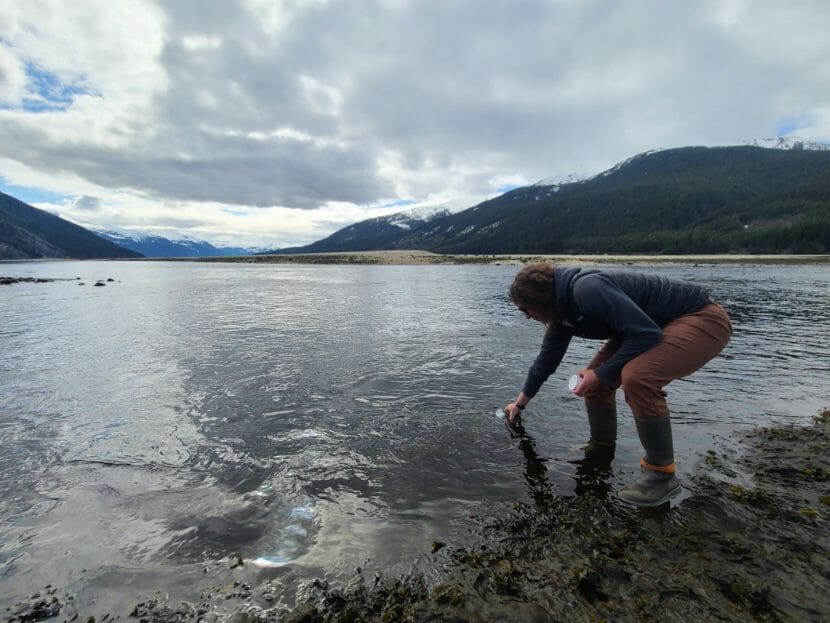
Eulachon, the small fish known in Lingít as saak, has returned to the upper Lynn Canal, marking a celebration of spring. The nutrient rich fish is essential for subsistence culture and marine life. A long-term research study is tracking the fish’s populations across Southeast Alaska to better understand and protect the species.
“It’s a little disconcerting that this is the second year in a row that we haven’t seen a run materialized on the Chilkoot River,” said Meredith Pochardt, a lead researcher with the Chilkoot Indian Association’s regional monitoring project for the fish population. “A few days ago, we saw a small school of fish move in, and there’s a lot of activity and it looked like you know there’s gonna be a bunch more fish that came behind them, and yet we just didn’t see them.”
Pochardt is at the river every day before and during the spring run, from mid April to mid May. The first telltale sign of the spring run is the sound of gulls and seabirds overhead, and seals, sea-lions and sometimes orcas in the water. Another method is gathering DNA.
“Yeah, there’s currently no fish in the Chilkoot River. But we’ll still take samples and see if you know, maybe some came in last night and spawned or maybe there’s some DNA around there we can still pick up from the samples,” she said.
Pochardt fills two large bottles with water from the estuary. Those samples will go to a lab at Oregon State University to analyze the environmental DNA and gauge fish population, ecology and distribution.
The research project launched in 2010, after an alert went out along the West Coast that the eulachon populations were in steep decline. They were labeled endangered in the waters off of Washington, Oregon and California.
It’s not only a spring food source for Lingít communities but also important for medicinal, cultural and social well-being.
“We used to go up to Klukwan, you know had a big travel and all that,” said longtime Haines resident Phillip Jackson. “[The elders] used to spend the whole day with us, and there’d be singing and dancing, you know. And then dipping crackers in the pot, and getting the meat out, with pilot bread. It was always so much fun. And hearing the elders talking in Lingít, telling jokes, giggling and laughing, it was the utmost for me.”
No eulachon in the Chilkoot River isn’t necessarily a bad sign. When and where the small smelt fish run from year to year can vary quite a bit.
Pochardt says there is a run in the Chilkat River this year. Dozens of residents were out with nets over the weekend, harvesting eulachon for oil and smoking.
A spring run was spotted in Skagway too, where Reuben Cash is the environmental coordinator with the Skagway Traditional Council.
“Starting on May 1, we went from, you know, a couple of hundred gulls down to the Taiya River and Dyea to several thousand. We saw sea lions coming cruising up the inlet heading that way, I guess there was a humpback whale in the inlet. So lots of activity,” Cash said.
Cash is also collecting water samples for DNA analysis in the Taiya and Skagway Rivers, as part of the regional initiative.
“I’ve heard reports that the way that the runs will usually work is there will be some scouts that will go up (first) before the main bulk of the fish will arrive,” he said. “And however they’re able to communicate with the rest of the colony of fish, the scouts are able to successfully find a place and the fish will enter the river and the run will kind of increase from there.”
He says the cruise ship season may have also impacted the runs.
“They have an aversion to noise, they really don’t like loud things. We’ve seen that and some other rivers around Southeast,” he said. “When there’s a lot of noise activity, the fish will just switch rivers. So my thought is that perhaps the scouts were coming out checking out the Skagway River and then activity from the tourist season just got to be too intense and so they abandoned the Skagway and perhaps went to the Taiya (River). Or they may have just turned around all together.”
Results from the DNA sampling will help tell the story later in the summer.
